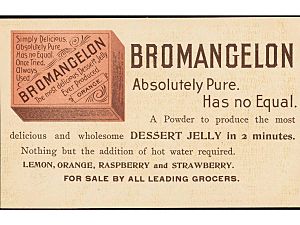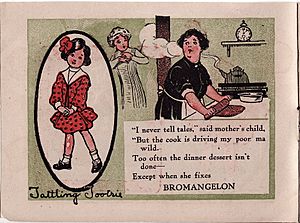Bromangelon facts for kids
Bromangelon was a popular dessert from the late 1800s to the early 1900s. It was a type of gelatin dessert, similar to what we know as Jell-O today. It was invented around 1895 by Leo Hirschfeld, who later created the famous Tootsie Roll candy. Bromangelon was special because it was the first powdered gelatin dessert that was sold widely to many people. It came out several years before Jell-O, which eventually became much more popular and caused Bromangelon to disappear from stores.
What's in a Name?
The exact meaning of the name "Bromangelon" isn't fully known. In 1895, the company that made it, Stern and Saalberg, Co., said the name meant "angel's food." This made it sound like a delicious and heavenly dessert!
However, a different idea about the name appeared in a magazine in 1903. It suggested the name might come from two Greek words: "bromos," meaning "a stench," and "angelus," meaning "a messenger" or "spirit." This is a very different idea!
Sometimes, advertisements for Bromangelon would split the name into "Bro-Man-Gel-On." This might have been done to make the long name easier for people to remember or say. It also might have hinted that the name was a portmanteau, which is a word made by blending parts of other words, like how Nabisco came from "National Biscuit Company."
How Bromangelon Changed Desserts
When Bromangelon first came out, it had four flavors: lemon, orange, raspberry, and strawberry. Over the next 15 years, they added more flavors like cherry, chocolate, and peach. By 1910, there were seven different flavors to choose from!
Gelatin, which is a product made from animal collagen, had been used in cooking for a long time, since the 1400s. But it was very hard and expensive to make at home. Chefs had to boil animal bones and tissues to get the gelatin out by hand. This meant that only very rich people could enjoy gelatin desserts.
Bromangelon wasn't the very first powdered gelatin. An inventor named Peter Cooper created powdered gelatin in 1845. But he was more interested in making glue, so his gelatin didn't become popular for food. Another product, Knox Gelatine, came out just before Bromangelon. It was popular, but you still had to soak its unflavored sheets in water before using them.
Bromangelon was special because it was the first flavored, instant gelatin powder. It was sold in small packets for about 10 or 15 cents, which would be about $3 or $4.50 today. It was quick, cheap, and tasted good! Suddenly, people at home could make fancy-looking desserts and side dishes in just "2 minutes time," as the ads claimed.
People got creative with Bromangelon. The company even suggested new ways to use it, like roast turkey with cherry Bromangelon, or Bromangelon sherbet. One cookbook from 1909 had a recipe for "Macaroon Bromangelon," a fancy dessert with ladyfingers, whipped cream, and strawberry Bromangelon. There was even a recipe from 1900 for a "Shredded Wheat Biscuit Jellied Apple Sandwich," which involved soaking shredded wheat in pink Bromangelon!
Jell-O was trademarked in 1897, two years after Bromangelon. Jell-O wasn't very successful at first. But in 1904, the company changed its marketing. They used colorful ads in magazines, gave away free samples, and focused on appealing to kids. Jell-O sales quickly grew to about $250,000 a year, which is like $7 million today! Bromangelon could never reach that level of fame, and it slowly disappeared by the 1930s.
Bromangelon and Tootsie Rolls
The person who invented Bromangelon was an Austrian Jewish immigrant named Leo Hirschfeld. He was a candy maker. In 1908, he trademarked Tootsie Rolls.
We don't know exactly how Bromangelon and Tootsie Rolls are connected. But the invention of chocolate Bromangelon around 1900 might be a clue. In 1907, representatives from Stern and Saalberg (the company that made Bromangelon and later Tootsie Rolls) visited Barre, Vermont. They showed off Bromangelon, but they also brought another product called "Tootsies." The local newspaper, the Barre Daily Times, reported that "Tootsies" was "made from Bromangelon."
Today's Tootsie Rolls don't contain gelatin, so it's unclear if this was an early version of the candy or something completely different. However, it's likely that Bromangelon's success helped Leo Hirschfeld become well-known at Stern and Saalberg. This probably gave him the support he needed to create a major candy product like the Tootsie Roll. By 1913, Hirschfeld was a vice president at Stern and Saalberg. The company later changed its name to Sweets Corporation of America in 1917 and then to Tootsie Roll Industries in 1966.
Meet Tattling Tootsie
Some advertisements for Bromangelon featured a character called "Tattling Tootsie." She was a cute little girl. A candy expert named Samira Kawash described her as a girl whose "mischief seems only tangentially connected to the joys of gelatin."
It's believed that Tattling Tootsie was inspired by Leo Hirschfeld's own daughter, Clara. Her nickname was "Tootsie," and this nickname later became the name for his famous Tootsie Roll candy!



